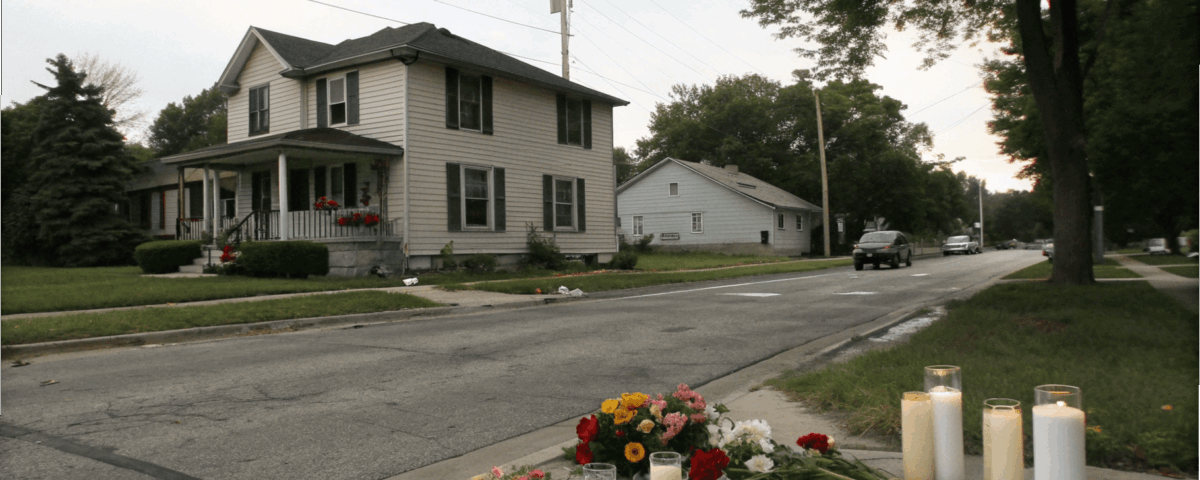
Shadondra Carruth33 – A Digital Creator’s Journey
August 28, 2025
Is Gabe Watson Still Married to Kim Lewis: Overview
September 8, 2025Irenia Cotner became infamous for orchestrating a deadly home invasion in Claremont, Illinois, in August 2005. As the leader of a self-proclaimed witch coven, Cotner targeted her ex-girlfriend, Lindsey Kasinger, believing she had been cursed. The attack escalated tragically, resulting in the death of 21-year-old U.S. Army soldier Joshua Bennett, who intervened to protect his mother. Cotner’s distorted beliefs in hexes and curses drove the premeditated crime, shocking the small Illinois community. The case has since drawn national media attention and remains a chilling example of how obsession and manipulative influence can turn supernatural beliefs into real-world violence.
The Irenia Cotner Case
Irenia Cotner became infamous for her involvement in one of the most shocking true crime cases in Claremont, Illinois. In August 2005, she led a self-proclaimed witch coven in a deadly plot that targeted her ex-girlfriend, Lindsey Kasinger. The attack escalated into a tragic home invasion that resulted in the death of Joshua Bennett, a 21-year-old U.S. Army soldier visiting his mother. This case gained widespread attention due to the bizarre involvement of occult practices, the planning of the murder, and the brutal consequences that followed. It is a chilling example of how personal vendettas and distorted beliefs can escalate into extreme violence.
The events surrounding the case shocked the small Illinois community and attracted national media attention. Cotner’s actions, driven by her belief in curses and hexes, led to multiple arrests and lengthy prison sentences. The Irenia Cotner case has since been analyzed in true crime shows, news reports, and documentaries, highlighting the dangers of obsessive beliefs combined with criminal intent.
Who Was Irenia Cotner?
Irenia Cotner was a 34-year-old woman from Claremont, Illinois, who led a dual life. By day, she worked as a Walmart employee, blending into her community and maintaining a seemingly normal routine. However, by night, Cotner was deeply involved in occult practices and led a small group that identified as a witch coven. She was known to have strong beliefs in curses, hexes, and the power of ritual magic, which she claimed could influence the lives of others. These practices became central to the events that unfolded in 2005, ultimately leading to her criminal actions.
Cotner’s role as the leader of her coven placed her in a position of influence over her accomplices. Members of her group followed her instructions and shared her belief that certain individuals had cursed them. Cotner’s intense focus on perceived threats, combined with her leadership in the coven, directly influenced the planning and execution of the violent crime. Understanding her background is essential to grasp the psychological and social factors that contributed to the tragic outcomes of this case.
The Birth of a Coven: Cotner’s Occult Involvement
Cotner’s interest in witchcraft was not merely a hobby; it was a driving force in her life. She organized and led a group of like-minded individuals who participated in occult rituals, believing in the supernatural power of curses and spells. This group, often referred to as a witch coven, conducted ceremonies and rituals that reinforced their shared beliefs. Cotner’s role as the coven’s leader gave her authority and influence, allowing her to direct the actions of other members toward her perceived goals.
The coven’s practices went beyond simple spiritual or symbolic rituals. Cotner convinced her followers that certain individuals, including her ex-girlfriend, had cast harmful hexes that needed to be removed. This belief system became the foundation for the criminal plan, merging superstition with violent intent. The coven’s collective mindset, fueled by fear and paranoia, created an environment where Cotner’s instructions were unquestioned, ultimately culminating in the deadly home invasion.
The Alleged Curse: Lindsey Kasinger’s Role
The central motivation behind Cotner’s crime was her belief that Lindsey Kasinger had cursed her. Cotner blamed Kasinger for her personal struggles, including depression and other emotional difficulties, which she interpreted as evidence of a hex or supernatural influence. Cotner’s conviction that removing Kasinger would lift the curse drove the planning and escalation of the attack. The idea of a perceived curse was a key factor that justified, in Cotner’s mind, the extreme measures she was willing to take.
Kasinger, who had no knowledge of the coven’s plans, became the target of a meticulously organized attack. Cotner’s belief in the curse overrode all moral and legal considerations, creating a dangerous situation for Kasinger and others present at her home. This alleged curse was not simply a psychological fixation but a motivating force that transformed Cotner’s personal grievances into a criminal conspiracy. The intensity of Cotner’s obsession with the curse was central to understanding the events of August 23, 2005.
Planning the Attack: A Deadly Conspiracy
The planning of the attack was methodical and rooted in Cotner’s belief in removing the alleged curse. She enlisted her coven members to carry out the assault, instructing them on how to approach the home of Lindsey Kasinger. The group conducted discussions about timing, roles, and potential obstacles, combining their occult rituals with criminal strategy. This premeditation illustrates the depth of Cotner’s commitment to her misguided beliefs and the extreme measures she was willing to take to achieve her goals.
During the planning phase, Cotner and her accomplices convinced themselves that the attack would remove the curse and restore balance in their lives. They prepared tools, devised a plan for entry, and coordinated their movements to ensure maximum impact. Unfortunately, this calculated conspiracy resulted in the fatal stabbing of Joshua Bennett, who had intervened to protect his mother. The meticulous planning highlights how deeply Cotner’s coven and her supernatural beliefs influenced the course of this tragic event.
The Night of the Attack: August 23, 2005
On the night of August 23, 2005, Irenia Cotner and her coven members executed their planned attack. The group broke into the home of Lindsey Kasinger, intending to confront her and perform their ritual to remove the alleged curse. The tension and fear within the coven were palpable, as they believed that failure could worsen the hex. What began as a ritualistic mission escalated into violence, demonstrating how Cotner’s distorted beliefs could manifest in real-world consequences.
During the invasion, the situation spiraled out of control. Joshua Bennett, visiting his mother at the time, intervened to protect his family. He was fatally stabbed, while others in the home sustained injuries. The tragic outcome underscored the dangers of Cotner’s obsession with the curse and the deadly potential of her leadership within the coven. This event shocked the Claremont community and drew immediate law enforcement attention.
Victims of the Home Invasion
The most tragic victim of Cotner’s plot was Joshua Bennett, a 21-year-old U.S. Army soldier. He was visiting his mother when the attack occurred and was killed while trying to defend his family. His death was a direct result of Cotner’s premeditated plan and her belief in the supernatural curse. Joshua’s loss highlighted the human cost of the coven’s dangerous ideology and brought national attention to the case.
In addition to Joshua Bennett, his mother, Jacqueline Bennett, suffered injuries during the attack. The incident also traumatized Lindsey Kasinger and her family, who were forced to confront the violent consequences of Cotner’s actions. The victims’ experiences serve as a reminder of how distorted beliefs and obsessive behavior can inflict pain on innocent lives, leaving lasting scars on the affected families and the wider community.
The Aftermath: Arrests and Charges
Following the home invasion, Irenia Cotner and her accomplices were quickly apprehended by law enforcement. The arrests were the result of a coordinated investigation that gathered evidence of the premeditated attack, including witness statements, physical evidence, and details about the coven’s activities. Cotner faced multiple charges, including first-degree murder, conspiracy to commit murder, and home invasion, reflecting the severity of the crime.
The arrests brought temporary relief to the Claremont community, which had been shaken by the violent attack. Cotner’s accomplices were also charged, highlighting the collective responsibility within the coven. Law enforcement emphasized that the crime was not only an act of violence but also a product of dangerous beliefs and manipulation. The legal process that followed aimed to ensure justice for the victims and prevent future acts inspired by similar delusions.
Courtroom Drama: Trials and Sentences
Irenia Cotner’s trial revealed the chilling details of her coven and the murder plot. Prosecutors presented evidence of premeditation, showing how Cotner orchestrated the attack to remove the alleged curse. Witness testimony, including statements from coven members and survivors, played a crucial role in demonstrating Cotner’s leadership role and intent. The trial exposed the full scope of the dangerous influence she had over her accomplices.
Ultimately, Cotner was convicted of first-degree murder, conspiracy to commit murder, and home invasion. She received a sentence of 57 years in prison, with parole eligibility set decades later. Her accomplices also faced lengthy sentences. The courtroom proceedings underscored the seriousness of the crime and the deadly consequences of Cotner’s distorted beliefs. The trial remains a notable example of how occult practices can intersect with criminal intent.
The Fate of Cotner and Her Accomplices
Following their convictions, Irenia Cotner and her coven members were sentenced to significant prison terms. Cotner herself received 57 years for her role in the murder and conspiracy, reflecting the severity of her actions. Her accomplices were also imprisoned, some receiving sentences that extended for decades. These outcomes served to demonstrate the justice system’s response to premeditated violence driven by dangerous ideologies.
Cotner is currently serving her sentence in an Illinois state prison. Her accomplices remain incarcerated, with limited opportunities for parole. The case has become a reference point in discussions of criminal behavior linked to occult practices, highlighting how personal beliefs and manipulation can escalate into lethal outcomes. The sentences also provide closure for the victims’ families while reinforcing societal accountability for such acts of violence.
Media Coverage: ‘Snapped’ and Public Reaction
The Irenia Cotner case received widespread media attention due to its shocking nature and the involvement of a witch coven. True crime outlets, local news, and national networks highlighted the case, focusing on the unusual blend of occult practices and violent crime. Oxygen TV featured the case in an episode of Snapped: Women Who Murder, offering an in-depth look at Cotner, her coven, and the events leading to Joshua Bennett’s death.
Public reaction was a mixture of horror and fascination. Viewers were drawn to the case due to its bizarre circumstances, including the use of rituals and the coven’s collective planning. The media coverage also sparked discussions about the psychological and social factors that drive individuals toward extreme behaviors, raising awareness of the consequences of obsessive beliefs and manipulation within small social groups.
Psychological Analysis: Understanding Cotner’s Motive
Irenia Cotner’s actions can be understood through a psychological lens that considers obsession, paranoia, and group influence. Cotner exhibited extreme belief in curses and hexes, which distorted her perception of reality. She blamed Lindsey Kasinger for her personal struggles, interpreting normal emotional challenges as evidence of a supernatural attack. This obsessive mindset fueled her determination to remove the alleged curse.
The coven structure amplified Cotner’s influence over others, creating an echo chamber where her beliefs were validated and reinforced. Groupthink and authority dynamics encouraged her accomplices to participate in the crime without question. Psychological experts analyzing the case have noted that Cotner’s combination of personal grievance, obsessive belief in the occult, and leadership over a suggestible group created conditions for violent behavior.
The Impact on the Claremont Community
The murder and home invasion deeply affected the Claremont community. Residents were shocked that such a violent act could occur in their small town, especially one driven by occult beliefs. Families, schools, and local organizations struggled to process the tragedy, while law enforcement and social services worked to reassure the public about safety and justice measures.
The case also prompted broader discussions about mental health, the influence of extremist beliefs, and the dangers of manipulative leaders within close-knit groups. Community members reflected on the warning signs leading up to the attack and emphasized the importance of early intervention when personal obsessions escalate to criminal behavior. The tragedy left a lasting mark on the town’s collective memory.
Lessons Learned: The Dangers of Cult Influence
The Irenia Cotner case illustrates the risks of cult-like influence and manipulation. Cotner’s coven demonstrated how charismatic leaders can persuade vulnerable individuals to engage in harmful behavior, especially when combined with strong beliefs in the supernatural. The case serves as a cautionary tale for recognizing early warning signs of extremist or obsessive group behavior.
It also emphasizes the importance of education, mental health support, and community awareness. By understanding how Cotner manipulated her followers, society can better identify and prevent similar tragedies. The case encourages reflection on the balance between personal belief systems and societal responsibility, highlighting how unchecked influence can lead to devastating consequences.
Reflecting on a Tragic Event
The tragic events surrounding Irenia Cotner and her witch coven remain a stark example of how personal grievances, obsessive beliefs, and group influence can culminate in violence. Cotner’s actions, driven by a perceived curse, led to the death of Joshua Bennett and lasting trauma for the victims and their families. The case continues to capture public attention through media coverage and true crime analyses.
Reflecting on the Irenia Cotner case offers valuable lessons about the dangers of distorted beliefs, manipulation, and extremism within small groups. It underscores the need for awareness, early intervention, and societal support systems to prevent similar tragedies. While justice was served through lengthy prison sentences, the case remains a chilling reminder of how obsession and misguided convictions can have deadly consequences.
FAQ’s
Who is Irenia Cotner?
Irenia Cotner was the leader of a self-proclaimed witch coven in Claremont, Illinois. She became infamous for orchestrating a deadly home invasion in 2005, targeting her ex-girlfriend and resulting in the death of Joshua Bennett.
What crime did Irenia Cotner commit?
Irenia Cotner was convicted of first-degree murder, conspiracy to commit murder, and home invasion. She and her coven members carried out a premeditated attack believing they were removing a curse.
When did the Irenia Cotner attack happen?
The attack occurred on August 23, 2005, in Claremont, Illinois. Cotner and her coven members broke into Lindsey Kasinger’s home, which tragically led to Joshua Bennett’s death.
What was the motive behind Irenia Cotner’s crime?
Cotner believed she had been cursed by her ex-girlfriend, Lindsey Kasinger. Her motive was to remove this alleged curse through a ritualistic attack, which escalated into a fatal home invasion.
What was the outcome of Irenia Cotner’s trial?
Irenia Cotner was sentenced to 57 years in prison for first-degree murder and conspiracy. Her accomplices also received long prison terms, ensuring justice for the victims and their families.
Conclusion
Irenia Cotner’s case remains a chilling reminder of how personal obsession and distorted beliefs can lead to tragedy. Her actions, driven by the conviction that she had been cursed, resulted in the death of Joshua Bennett and lasting trauma for the victims and their families. The events highlighted the dangers of manipulative group dynamics and the influence of extreme occult beliefs. Cotner’s imprisonment served justice, but the case continues to be studied in true crime circles as a cautionary tale. It underscores the importance of mental health awareness, early intervention, and understanding how dangerous obsessions can escalate into violent acts.
Related Psot:





